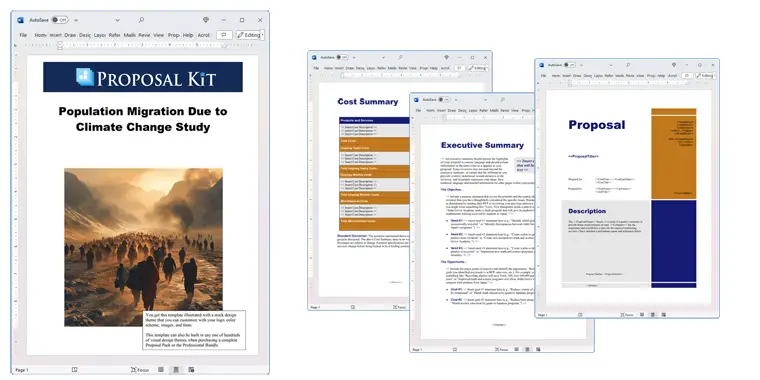How to write your Population Migration Due to Climate Change Study
We include this 20 page layout with every Proposal Pack. If you want this template to have a different visual design theme than the one illustrated here, purchase any Proposal Pack design and create this template using the purchased design theme. This template is included in every Proposal Pack. If you get a Proposal Pack or the Professional, you can also make any variation of this template with different chapters to suit your needs.
We typically include more chapters in the templates than most people will need to give everyone more variety in the chapters they may need. You can trim down a long template by removing pages you do not need or combining multiple chapter topics into one page.
 DOWNLOADABLE, ONE-TIME COST, NO SUBSCRIPTION FEES
DOWNLOADABLE, ONE-TIME COST, NO SUBSCRIPTION FEESYou can also create countless variations of this document to suit your needs using the included library of 2200+ chapters if ordering a Proposal Pack or Professional.
 What Our Clients Say
What Our Clients SayRunning a non-profit is hard enough. With the help of the Proposal Pack it allowed us the template we needed to help get our proposal off to a successful start! The professional look I wanted was already created no need to reinvent the wheel just use what was already there. The Proposal Kit folks already knew what would work and it did for us."
Executive Director
Who’s Positive
Related Article
Related Video
Related Templates
- Extinction and Climate Change Study
- Climate Change Research Proposal
- Research Funding Request Proposal
- Case Study Report
- Research Expedition Grant Funding Request
- Climate Change Natural Resources Replenishment Problems Report
- Research Proposal (Short)
- Climate Change Causing Natural Resources Replenishment Problems Report
- Natural Resources Management Proposal
What's the best way to write your population migration due to climate change study?
A proven solution for creating a comprehensive and persuasive population migration due to climate change study is using the Proposal Kit template and software package. This suite of tools not only simplifies the writing process but integrates a powerful line item quoting database system. This system is invaluable for creating detailed cost summaries, quotes, estimates, budgets, and other crucial financial documents for backing up your study with solid numbers.
Are you tasked with writing a study on this topic? If so, the Proposal Kit is designed for you. The Proposal Kit is designed to write complex studies, reports, and proposals.
What Types of Projects Are Population Migration Due to Climate Change Studies Written For?
Population migration studies related to climate change are important for various situations that seek to understand and mitigate the impacts of environmental changes on human movement. These studies are typically written for:
- Government policy development
- Non-governmental organization (NGO) initiatives
- Academic research projects
- Community planning and urban development
- International aid proposals
- Climate adaptation strategies
- Environmental impact assessments
- Sustainable development programs
- Disaster preparedness plans
- Human rights advocacy
- Public health responses
- Economic forecasting
- Agricultural planning
- Water resource management
- Energy sector adaptation
- Insurance industry analysis
- Real estate forecasting
- Tourism industry adjustments
- Transportation planning
- Cultural preservation efforts
Chapters this template is built with
While every study is unique, Proposal Kit helps you create a study tailored to your needs with its extensive template library and document creation software. Here's how you can use some of the Proposal Kit templates to cover important topics in your population migration due to climate change study:
Cover Letter
Your proposal begins with a professional cover letter, setting the stage for the following detailed study. The cover letter introduces the study's purpose, the problem of climate-induced migration, and the importance of understanding and addressing this issue for stakeholders.
Abstract
Summarize your study's aims, methods, and anticipated outcomes. The abstract serves as a snapshot of what the study will cover, including key questions about how climate change impacts migration patterns and what solutions might be proposed.
Risk Analysis
Evaluate the risks associated with climate change and how they might drive migration. This section will include an assessment of potential threats, such as increased frequency of natural disasters or gradual environmental degradation, and their effects on communities.
Environmental Effects
Discuss the direct environmental changes prompting migration, such as sea-level rise or desertification. Explain how these changes alter living conditions, making certain areas uninhabitable and forcing populations to relocate.
Consequences
Explore the potential societal and economic consequences of migration patterns. This includes the strain on infrastructure in receiving areas, shifts in labor markets, and the social integration challenges migrating populations face.
Methodology
Detail the methods you will use to gather data and analyze migration trends. This might include surveys, satellite imagery, historical climate data, and interviews with affected populations to ensure a comprehensive understanding.
Migration
Provide an overview of the migration patterns observed or predicted. This section will map out where populations are moving from and to, identifying key migration corridors and the demographic characteristics of the migrating populations.
Impact Statement
Articulate the broader impacts of migration on original and destination communities. Discuss how migration affects the region's losing population and those gaining new residents, including changes in social dynamics and economic conditions.
Displacement
Address the issue of forced displacement due to environmental factors. Focus on how sudden events like hurricanes or long-term changes like droughts can displace communities, necessitating immediate and long-term responses.
Depletion
Discuss the depletion of natural resources as a factor in migration. This includes how water scarcity, arable land, and other critical resources can drive populations to seek more sustainable living conditions elsewhere.
Natural Resources
Examine how the changing availability of natural resources influences migration. This involves a detailed look at which resources are becoming scarce, how this affects livelihoods, and the resulting movements of people.
Climate Change
Connect the dots between broad climate change phenomena and specific migration incidents. Explain how larger trends in global warming, such as temperature increases and changing weather patterns, directly contribute to migration.
Predictions
Offer predictions based on current trends and data analysis. Use your gathered data to forecast future migration situations, helping stakeholders prepare for challenges and opportunities.
Analysis
Delve into the data collected and provide a thorough analysis. This section will interpret the data to understand the causes and effects of migration, using statistical tools and graphical representations to support your findings.
Conclusions
Wrap up your study with solid, data-backed conclusions. Summarize the key findings and their implications, and recommend actions or policies to address the challenges identified in your study.
References
Cite all references used to lend credibility and authority to your study. This includes academic papers, government reports, and other data and information sources used in your research.
Data
Present the raw data supporting your study's findings and conclusions. This might include tables, charts, and raw numbers used in your analyses, offering transparency and the opportunity for peer review.
Use cases for this template
Overcoming Data Overload in Environmental Consulting
The Challenge
Alice, an environmental consultant at GreenFuture Insights, faced an overwhelming task. She needed to compile extensive data into a coherent study addressing the migration caused by deforestation in the Amazon. The vast amount of data from various sources and the complexity of the environmental impacts made it difficult for her to create a structured and persuasive narrative.
The Solution
Alice turned to Proposal Kit, recognizing its potential to streamline her workflow and organize the voluminous data. The software's structured templates provided a framework that made it easier to categorize information systematically. Alice selected templates specifically designed for environmental studies, such as Risk Analysis, Environmental Effects, and Data.
The Implementation
Alice began by inputting her data into the provided templates. The chapters on Data and Analysis were particularly useful, as they allowed her to present her findings in a clear, logical format. She filled in each section, ensuring that every piece of data was accurately represented. The Proposal Kit's intuitive interface made it easy for her to focus on the content rather than the formatting.
The Outcome
The structured approach won her firm the contract and set a new standard for future proposals. GreenFuture Insights now uses Proposal Kit as their go-to tool for proposal and report writing, appreciating the final documents' ease of use and professional quality. Alice's success story has been shared within the company as a best practice, encouraging other consultants to adopt the same methodology.
Fast-Tracking a Municipal Climate Action Plan
The Challenge
Bob, a municipal planner for the city council of Sunville, was under pressure. He was tasked with writing a climate action plan focused on potential population migration due to coastal flooding. The council needed the proposal urgently to secure funding and initiate preventive measures. Bob had limited time and resources, making the task seem almost impossible.
The Solution
In search of a rapid yet effective solution, Bob chose Proposal Kit for its ready-to-use templates and document assembly software. The templates provided a comprehensive structure, while an AI tool offered insightful suggestions that expedited the writing process. Bob used templates like Abstract, Environmental Effects, and Impact Statement to frame his study.
The Implementation
Bob used the AI tool's capabilities to analyze existing data and generate content for specific study sections. This integration allowed him to quickly write the necessary chapters without sacrificing quality. The intuitive Proposal Kit software enabled him to format the study and include detailed financial estimates using the line item quoting database.
The Outcome
Bob's efficiently created study was completed ahead of the tight deadline and was well-received by the city council. The document's clarity and thoroughness secured the necessary funding for Sunville's climate initiatives. The study not only met the immediate needs of the council but also established a model for future climate action plans in Sunville.
Raising Awareness Through Non-Profit Advocacy
The Challenge
Carol, a director at the non-profit Save Our Shores, faced the challenge of raising awareness about climate-induced displacement in coastal communities. She needed to write an RFP for a comprehensive study to attract researchers and partners. However, Carol was unsure how to structure the RFP to communicate the urgency and scope of the project.
The Solution
Carol decided to use Proposal Kit, confident in its ability to provide a robust framework for her RFP. She focused on templates that aligned with her non-profit's mission, such as Environmental Effects and Impact Statement. These templates helped her articulate coastal displacement's environmental and societal impacts clearly and persuasively.
The Implementation
Carol customized the templates to reflect Save Our Shores' specific objectives. She included detailed sections on the anticipated outcomes, methodological approaches, and potential benefits of the study. The Proposal Kit's extensive library allowed her to tailor each chapter to address the key concerns of prospective research partners.
The Outcome
Carol's detailed and persuasive RFP attracted top-tier researchers and organizations eager to collaborate on the study. The newfound partnerships enabled Save Our Shores to undertake a research project on coastal migration. The success of the RFP also bolstered Carol's reputation as an effective leader within the non-profit sector, paving the way for future advocacy initiatives.
Conclusions and Recommendations
Proposal Kit provides all the tools necessary to create a population migration due to climate change study, from writing detailed financial estimates to organizing complex research data. Whether you're a consultant, a municipal employee, or a non-profit director, Proposal Kit streamlines the proposal writing process, ensuring you can focus on what matters - delivering impactful insights and solutions.
Also Known As
This template may also be referred to in different ways or be used in more specialized situations, such as:
- Climate Change Migration Analysis
- Environmental Displacement Study
- Resource Scarcity and Population Shift Research
- Global Warming Impact on Migration Report
- Ecological Migration Patterns Study
- Climate-Driven Population Movement Research
- Environmental Change and Human Migration Analysis
- Climate Migration Scenario Planning
- Sustainability and Forced Migration Study
- Resource Depletion and Migration Patterns Report
Abstract
 In recent decades, climate change has emerged as a significant driver of human mobility worldwide, compelling millions of people to migrate due to its various impacts. As the global average temperature rises, climate events such as severe droughts, river flooding, and extreme temperatures have increasingly forced communities to relocate. This phenomenon, often referred to as climate-related migration, affects both low and middle-income countries, particularly in vulnerable regions like Sub-Saharan Africa, South Asia, and Latin America. Internal climate migrants, those who move within their own country due to these environmental drivers, face numerous challenges, including economic instability and food insecurity.
In recent decades, climate change has emerged as a significant driver of human mobility worldwide, compelling millions of people to migrate due to its various impacts. As the global average temperature rises, climate events such as severe droughts, river flooding, and extreme temperatures have increasingly forced communities to relocate. This phenomenon, often referred to as climate-related migration, affects both low and middle-income countries, particularly in vulnerable regions like Sub-Saharan Africa, South Asia, and Latin America. Internal climate migrants, those who move within their own country due to these environmental drivers, face numerous challenges, including economic instability and food insecurity.
Developed countries, while also experiencing climate-driven migration, often serve as destination countries for those seeking refuge from climate threats such as coastal erosion and land degradation. The Internal Displacement Monitoring Centre and other international organizations emphasize the urgent need for sustainable development goals and targeted interventions to combat climate change and its effects on migration patterns.
Proposal Kit offers a comprehensive solution for creating detailed studies on climate-induced migration. With its extensive library of templates and automated line-item quoting, Proposal Kit streamlines the document creation process, allowing researchers to focus on analyzing the impacts of climate variability. This includes the effects of rapid population growth in urban areas, the depletion of agricultural livelihoods, and the strain on basic infrastructure in host communities.
 As the climate crisis continues, understanding climate-driven displacement becomes important. By using the Proposal Kit, policymakers, NGOs, and researchers can develop effective adaptation measures, ensuring that affected communities receive the necessary support and resources to mitigate the adverse effects of climate change on human migration.
As the climate crisis continues, understanding climate-driven displacement becomes important. By using the Proposal Kit, policymakers, NGOs, and researchers can develop effective adaptation measures, ensuring that affected communities receive the necessary support and resources to mitigate the adverse effects of climate change on human migration.
Climate-related migration is an increasingly pressing issue as climate change continues to reshape human mobility patterns. Rising temperatures and environmental disasters, such as floods and wildfires, adversely affect vulnerable populations by exacerbating food security and health risks. In regions like Sub-Saharan Africa, South Asia, and Latin America, climate change-induced migration is driven by a combination of push factors, including severe droughts, soil degradation, and economic instability. This leads to both internal migration and cross-border movements, significantly impacting global migration trends.
The Proposal Kit assists stakeholders in creating detailed studies that address the complexities of climate-driven migration. With its extensive content libraries and automated document assembly, Proposal Kit enables users to create data-driven reports and proposals that explore migration drivers, such as political instability, economic opportunity, and environmental conditions. By using these tools, users can analyze the impacts of climate change on agricultural production, urban settings, and informal settlements, providing valuable insights into migration outcomes and future situations.
 In developed countries, climate refugees often face limited access to important services and economic opportunities, while in less developed countries, internal displacement places a significant burden on infrastructure and health services. The Internal Displacement Monitoring Centre highlights the need for urgent action and adaptation measures to mitigate the effects of climate mobility on entire communities. Addressing these challenges is crucial for achieving sustainable development goals and safeguarding cultural heritage.
In developed countries, climate refugees often face limited access to important services and economic opportunities, while in less developed countries, internal displacement places a significant burden on infrastructure and health services. The Internal Displacement Monitoring Centre highlights the need for urgent action and adaptation measures to mitigate the effects of climate mobility on entire communities. Addressing these challenges is crucial for achieving sustainable development goals and safeguarding cultural heritage.
As climate impacts continue to evolve, it is important to consider the role of political factors in exacerbating migration pressures. Additionally, regions affected by frequent climatic hazards, like the Middle East and North Africa, require planning to cope with the ongoing changes. Proposal Kit facilitates the development of comprehensive policy proposals and academic literature, helping to ensure that affected communities receive the support needed to adapt and thrive in a warming climate.
The impacts of climate change on migration are profound and multifaceted, affecting millions of people globally. By using tools such as Proposal Kit, policymakers, researchers, and NGOs can better understand and address the challenges associated with climate change and migration, ultimately fostering resilience and promoting economic growth in regions facing the greatest risks.
 Climate related migration continues to reshape the demographic landscape across many countries, driven primarily by the impacts of climate change and exacerbated by economic factors. Middle income countries in regions such as South Asia, Latin America, and Sub-Saharan Africa are witnessing a surge in internal climate migrants, who are forced to relocate due to sudden or progressive changes like extreme heat, drought, and flooding. These climatic conditions pose significant challenges to human security and economic growth, leading to a complex web of migration and displacement.
Climate related migration continues to reshape the demographic landscape across many countries, driven primarily by the impacts of climate change and exacerbated by economic factors. Middle income countries in regions such as South Asia, Latin America, and Sub-Saharan Africa are witnessing a surge in internal climate migrants, who are forced to relocate due to sudden or progressive changes like extreme heat, drought, and flooding. These climatic conditions pose significant challenges to human security and economic growth, leading to a complex web of migration and displacement.
The Internal Displacement Monitoring Centre reports that hundreds of millions are potentially leading a life of uncertainty due to climate disasters, with internally displaced persons forming a significant portion of vulnerable populations. In high-income countries, rising temperatures and climate-driven migration highlight the need for comprehensive adaptation strategies. Refugee camps and informal settlements are becoming increasingly prevalent as people flee from high-risk areas in search of safety and stability.
Cross-border migration, often triggered by severe disasters and political instability, impacts both origin and destination countries. The Middle East and North Africa, for instance, are experiencing heightened levels of migration driven by a combination of pull factors such as economic opportunity and push factors like food scarcity and water availability. Civil war has further complicated the migration routes across regions, leading to mass migration and significant humanitarian concerns.
 Proposal Kit provides important tools for creating robust reports on these migration patterns, offering extensive content libraries that simplify the complex documentation required. By analyzing migration drivers, such as agricultural decline and land use changes, stakeholders can develop targeted interventions to minimize the adverse impacts on affected communities. Using Proposal Kit's capabilities allows for an evidence-based approach, enabling policymakers to plan for future situations and ensure sustainable development in the global south.
Proposal Kit provides important tools for creating robust reports on these migration patterns, offering extensive content libraries that simplify the complex documentation required. By analyzing migration drivers, such as agricultural decline and land use changes, stakeholders can develop targeted interventions to minimize the adverse impacts on affected communities. Using Proposal Kit's capabilities allows for an evidence-based approach, enabling policymakers to plan for future situations and ensure sustainable development in the global south.
Efforts to combat climate change-induced migration must consider the cultural heritage and socioeconomic status of displaced populations, particularly in the global south. Initiatives like building sea walls and improving agricultural production aim to protect these communities from the adverse effects of climate change. The Paris Agreement and other international frameworks play an important role in addressing these issues by setting targets to reduce greenhouse gas emissions and promote resilience.
In conclusion, the phenomenon of climate related migration is a testament to the ongoing challenges posed by environmental changes. As the global population continues to grow, it is imperative to address the drivers of migration and displacement to foster a more equitable and sustainable future for all.
Frequently Asked Questions
What is the first step in writing a population migration due to climate change study?
The first step in writing a population migration due to climate change study is to define the scope and objectives of your study thoroughly. Begin by identifying the specific climate change phenomena that will be the focus of your research, such as rising sea levels or increased frequency of extreme weather events. Using the Proposal Kit, you can access a variety of templates like the Abstract and Methodology sections, which help you clearly outline the purpose and approach of your study. Starting with a well-defined scope ensures that your study remains focused and relevant to the specific issues you aim to address.
How do I gather and organize data for my population migration due to climate change study?
Gathering and organizing data is crucial for population migration. Begin by collecting quantitative and qualitative data from reputable sources such as government reports, academic research, and field surveys. Proposal Kit's Data and Analysis templates are handy for structuring this data coherently. The software allows you to integrate charts, graphs, and tables, making your data more accessible and impactful. Proper organization strengthens your study and makes it easier for stakeholders to understand and act upon your findings.
What should be included in the risk analysis section of my population migration due to climate change study?
The risk analysis section of your population migration study should detail the potential threats and vulnerabilities associated with climate-induced migration. Use Proposal Kit's Risk Analysis template to systematically evaluate risks such as loss of livelihoods, health impacts, and social tensions in source and destination areas. By providing a comprehensive risk assessment, you can help policymakers and stakeholders develop more effective strategies to mitigate these risks. Including real-world examples and case studies can further illustrate the potential consequences and underscore the urgency of your findings.
How can I communicate the findings of my population migration due to climate change study to a non-specialist audience?
Communicating your findings to a non-specialist audience requires clarity and simplicity. Use the Proposal Kit's Impact Statement and Conclusions templates to summarize your research in straightforward, non-technical language. Highlight key findings and their implications for society, economy, and the environment. Visual aids such as infographics and summary tables can also help convey complex information more clearly. Ensuring that your study is accessible to a broad audience increases its impact and the likelihood that your recommendations will be implemented.
How do I ensure the credibility and reliability of my population migration due to climate change study?
Ensuring credibility and reliability is important for any scientific study. Start by sourcing data from reputable, peer-reviewed journals, government publications, and authoritative organizations. Use Proposal Kit's References template to cite all sources, providing transparency and allowing others to verify your data. Additionally, including a Methodology section that details your data collection and analysis processes lends further credibility. Collaborating with experts in the field and seeking peer reviews can also bolster the reliability of your study, making it a trusted resource for decision-makers and stakeholders.
20% Off Discount
![]() Add To Cart This Word Template
Add To Cart This Word Template
 Add To Cart Proposal Pack for Any Business
Add To Cart Proposal Pack for Any Business
 Add To Cart Proposal Kit Professional
Add To Cart Proposal Kit Professional
 4.7 stars, based on 849 reviews
4.7 stars, based on 849 reviewsProposal Kit chapters used in this template
Cover Letter, Title Page, Table of Contents, Abstract, Climate Change, Environmental Effects, Natural Resources, Depletion, Displacement, Migration, Methodology, Risk Analysis, Consequences, Impact Statement, Analysis, Predictions, Conclusions, References, Data, Back Page
You use this proposal for
- General business proposal
- Non-technical proposal
- Business document, study, plan, report
How to create this template with Proposal Pack Wizard
You can create this document using any of the logo-designed Proposal Packs. Pick any Proposal Pack with a logo design theme you like best; they will all work equally well. The Proposal Pack for Any Business is the pack with no extra added logos or colors - designed to be used plain or for you to customize with your logos and graphics.
The Proposal Pack design theme you purchase will determine the visual look of this template. The screenshot above only shows the plain generic design theme.
We include a library of chapters to be assembled based on your needs. All proposals are different and have different needs and goals. We designed Proposal Pack so you can customize the documents to suit your needs.
You will best create this document using the Proposal Pack Wizard - Expert Edition software to select this template and build it in the Proposal Pack logo design theme of your choice along with any desired customizations (such as adding additional chapters, removing unneeded chapters, changing the order of chapters, and importing your company logo). This template outlines a proposal for the described situation. Each user is responsible for typing in the actual content of the provided pages with their information to complete the proposal. Suggestions in the abstract may include features in higher-end packages and are facilitated by the selection of chapter templates to support the narrative of each proposal, which help guide the user in filling in the details.
The Wizard software's AI Writer will write the content of the pages of the template based on details provided for your company, client, project, financial details and other writing instructions. This will provide a personalized version of the template completely written and ready to edit.
Once finished, the AI Writer's Word-to-PowerPoint converter can transform your proposal, business plan, or other business documents into a PowerPoint slideshow. Save time and effort by letting the AI analyze every chapter to condense its content into talking points, visually matching the document, and providing a consistent package of presentation material with the click of a button.
You create this template using the Wizard software with an entire Proposal Pack library and software. We include the Expert Edition of the software in the Proposal Kit Professional. Microsoft Word for Windows is required to use the customizing software. You can also edit Word document templates in other office software such as Word for Mac. We will assist Mac users in assembling complex templates for their first project if they do not have the required platform to run the Wizard software.
How to Build Templates Featured on Proposal Kit Website
Many people find the Proposal Kit website after searching for a specific proposal. Once you've purchased and installed the software, how do you build that template you found in the first place? This video shows you how to build any proposal you see on the Proposal Kit website.
 Ian Lauder has been helping businesses write their proposals and contracts for two decades. Ian is the owner and founder of Proposal Kit, one of the original sources of business proposal and contract software products started in 1997.
Ian Lauder has been helping businesses write their proposals and contracts for two decades. Ian is the owner and founder of Proposal Kit, one of the original sources of business proposal and contract software products started in 1997.By Ian Lauder
 Published by Proposal Kit, Inc.
Published by Proposal Kit, Inc.


 Cart
Cart
 Get 20% off ordering today:
Get 20% off ordering today: 


 Facebook
Facebook YouTube
YouTube Bluesky
Bluesky Search Site
Search Site